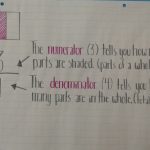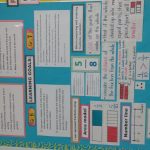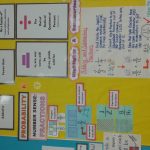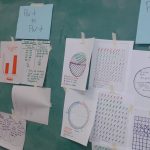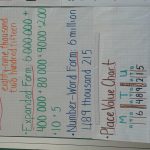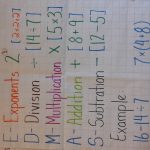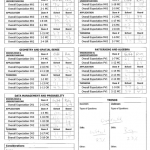Teachers will work with the Learning Centre mathematics coach to refine and share best practices in mathematics. Based on EQAO mathematics scores and observations within the math classroom, teachers will target math concepts, math strategies, teaching strategies, math tools, math manipulatives and high-yield strategies to refine/explore best practices. We will also examine student learning trajectories in mathematics. Teachers will explore new resources and try their implementation into the classroom to support a variety of learners as they improve their math learning.
Team Members
Anna Meszesan
Toronto District School Board
Alana Eckler Guinane
Toronto District School Board
Grace Lim
Toronto District School Board
Quincy Richards
Toronto District School Board
Professional Learning Goals
- Learned how to collect, triangulate and use data more effectively to identify needs and plan next steps
- Explored math learning trajectories for middle school students
- Explored transitions from manipulative (or concrete) learning, through representation models, to abstract thinking
- Created common, easily accessible spaces for sharing and collaboration in mathematics
- Collaborated as a team more regularly around best practices and professional growth
- Shared learning with whole school as we transition to an embedded special education model
Activities and Resources
- Learned how to disaggregate EQAO results based (full school versus gifted program) to identify learning gaps by specialty programs within the school
- Triangulate data with classroom observations and reporting data
- Reviewed TDSB’s Expected Practice document
- Shared diagnostic tasks and support resources (for each grade)
- Professional learning with math coach on Leaps and Bounds (as a diagnostic task and/or intervention task)
- Unpacked Leaps and Bounds diagnostic tasks to look for learning trajectories of math concepts between grades
- Collaborate in teams to share best practices (commonalities and differences for students in regular program versus gifted programming)
- Refine teaching practice on three-part lessons and balanced math programming
- Revisited long-range plans – compared to curriculum document and commonly used textbook (add math tools and manipulatives to the plans)
- Continue to deepen understanding of learning trajectories in mathematics
- Researched (CRA approach – Singapore math) to build understanding of student learning from concrete, to representational (pictorial), to abstract
- Researched how CRA approach is found in math curriculum and Leaps and Bounds resource
- Completed various diagnostic tests in class with students and tried intervention/teacher lesson plans
- Co-teaching in class with math coach (between release time days)
- Build commonalities between classrooms (diagnostics and high-yield strategies)
- Personal reflection and goal setting (continuously) to determine needs and next steps
Unexpected Challenges
During this project, we had many challenges. Both of our grant participants had a change in members due to various reasons that included:
- Teachers leaving school on sick leave
- Teachers taking on alternate leadership opportunities (RMS lead teachers)
- Clarification or flushing out of goals for each team
We also struggled with the following:
- Difficulty getting supply teachers for so many teachers and within a middle school environment (supply teachers for project and regular teacher absences)
- Changes in messaging from director/board about timeline for integration of HSP and special education students into regular streamed classes/programs (how quickly might we need to share project with other teachers?)
- Navigating between hard copy and online resources (CD, hard copy or online resources) – finding what met teacher needs before buying a costly resource
Enhancing Student Learning and Development
- Students have more common high-yield strategies utilized within same grade classrooms and within the school
- Students have increased confidence in mathematics and how to choose an entry point into a task while problem-solving
- Students are continuing to explore the connection between manipulatives, tools and standard algorithms
- Students will be able to see intentional planning of math anchor charts and success criteria on the walls within classrooms
Sharing
- All work will be shared with staff electronically (through a collaborative space create on Google Drive)
- Teachers will receive full professional learning on project results during a June planning/sharing session with new grade teams
- Share visual images with teachers from co-teaching lessons in various classrooms
- Share learning with teachers from other schools through demonstration classes in mathematics
- Professional learning process and outcomes will be shared with superintendent (to be shared with other schools in family of schools), including next steps for the coming school year
Project Evaluation
Our project was definitely a success as we all had many new learning opportunities to learn and time to participate in professional discourse. We all took risks, learned from each other and tried something new in our programs to support student achievement. We are still in the early stages of implementing the Leaps and Bounds diagnostics and supporting tasks, however, we are excited to continue exploring how a diagnostic that includes a learning trajectory of skills for a given math concept can help teachers identify student learning gaps and support next steps planning.
Things we might have done differently would be starting earlier in the year. Having the time in June to prepare for September and all of first term will definitely help get us on the right track and feel more prepared to jump into programming math units that are responsive, targeted and meet the individual needs of our students.
Personal Team Member Reflections:
Team Member 1 – The personal success I had during the project included:
“The coach’s work with me at Donview was extremely valuable. I especially found the co-teaching opportunities to be an effective way of improving my teaching skills in math. The demonstrations she provided showed me how to do a quick formative assessment and then use the student work as a teaching example. All of her three-part lessons provided me with ideas about encouraging the use of math tools and creating success criteria for students to refer back to later. I teach a Grade 8 gifted class and many of my students are well beyond grade level in math. For this reason, I was initially skeptical that the co-teaching lessons would be useful for my group. However, I was thrilled to learn that the lesson topics were extremely useful as they can be applied to any math strand and every grade and level of math expertise (effective communication in math and using a number line). Overall, this was an excellent experience for me – the coach helped to gently pushed my thinking and left me feeling energized and inspired about teaching math!” – Grade 8 teacher
Team Member 2 – The personal success I had during the project included:
“Reflecting back, I found a few key moments really impacted me and changed my practice for the better. While working with the math coach between sessions, I was able to see what a three-part lesson looked like and, more specifically, how to co-construct the Highlights & Summary with my students. I could see how important it was to “pull out the math” and consolidate the ideas they had been working on by intentionally writing them out. I now have added this to my practice and build upon the Highlights & Summary throughout the unit.
The second key change is my visual math board in the classroom. I post examples that we use in class, key vocabulary and the big ideas we pull out for each concept (we’ve included pictures of this in our resources section). I notice the kids in the class use it often to remind themselves what to do and I even have students asking to sit at the back of the room (closer to the math wall) while working on a given task, in order to be closer to the board to reference it frequently.
The Leaps and Bounds assessment tests I was skeptical about at first since I teach a gifted class that often excels at calculations. However, I found it really helpful to do the diagnostic as it helped to show me gaps in student learning for thinking, communication and application of skills – not just the knowledge tests they were use to.” – Grade 7 teacher
Team Member 3 – The personal success I had during the project included:
“I found reviewing out long-range plans and comparing them to the math curriculum document and our commonly used textbook really helpful. Not only did we see that our long-range plans weren’t always being followed, but we also saw how much our textbook did not match the actual math curriculum we were to be teaching. This was causing some teachers to spend time teaching math concepts that were above the grade level for our students.
Similarly, I found unpacking the Leaps and Bounds tests really helpful. It helped me to see the trajectory of math learning, what the kids were already exposed to and where I should be heading. It outlined the tools and manipulatives that support student learning with the math concept. Focusing on these manipulatives/tools and extending the learning to bridge the more abstract concepts was really valuable learning, not just for my students but also for me (e.g., I heard a student who was working on fractions in class say, ‘You can’t use a circle for everything, it’s too hard. Use the 10×10 grid.’
Finally, it was also helpful to work with the math coach in the class between release days. I could see how she would ask the kids specific questions to pull out their thinking, not just show them how to do the math. This helped the kids to make connections to prior learning.” – Grade 6 teacher
Resources Used
Ontario Mathematics Curriculum
http://www.edu.gov.on.ca/eng/curriculum/elementary/math18curr.pdf
Curriculum correlation charts (Nelson – Leaps and Bounds)
Leaps and Bounds Teacher and Student resource – Nelson (hard copy and electronic versions)
Google Drive (GAFE applications)
Learning Centre math coach (human resource)
Resources Created
These resources will open in your browser in a new tab, or be downloaded to your computer.


